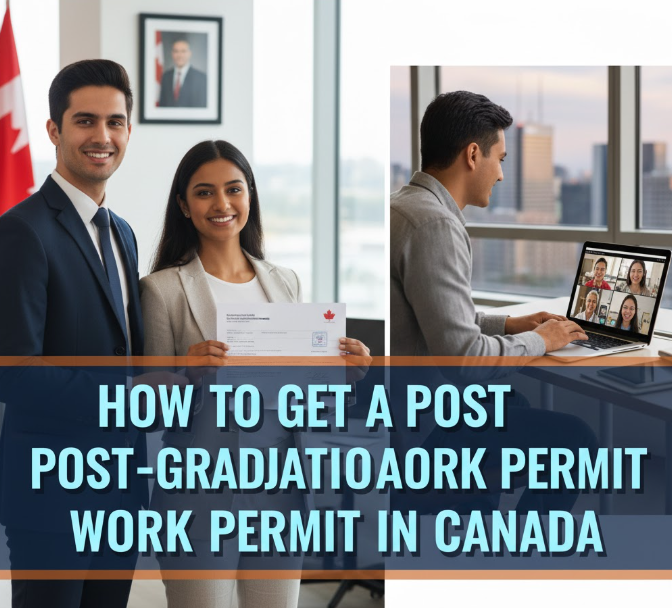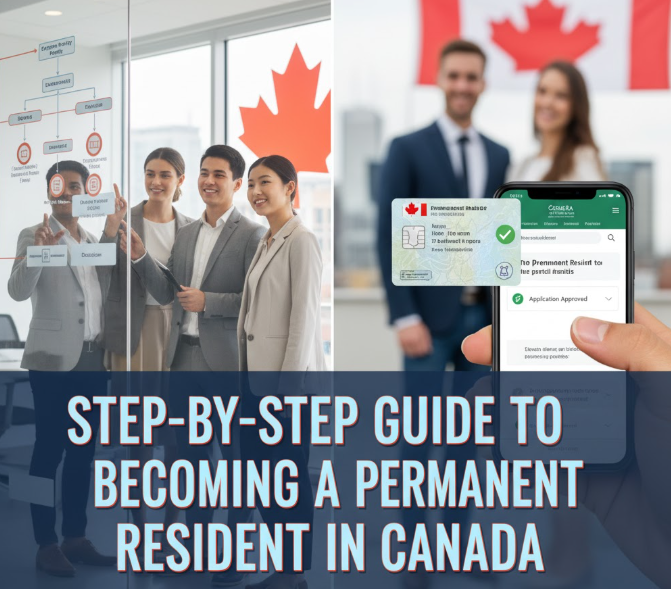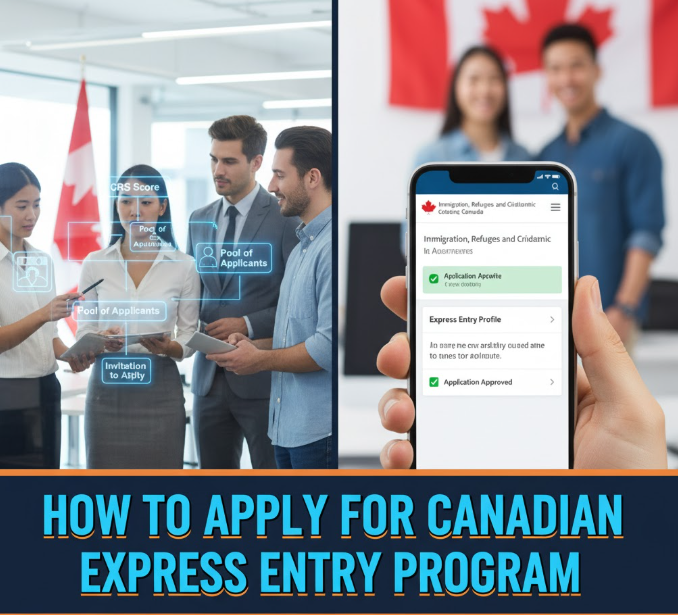So, you’ve just completed your studies in Canada – a great achievement; but what happens now? The answer for thousands of international students each year is the Post-Graduation Work Permit (PGWP). This special work permit allows you to remain in Canada and get valuable work experience after you graduate. For many students, whether you hope to launch your career in Toronto, Vancouver or anywhere else in Canada, the PGWP is your key to doing so.
Securing a work permit could sound complicated, but don’t be concerned. This guide explains everything you need to know in easy-to-follow steps. We will guide you on who is eligible to apply, what documents you’ll need, how to file your application and common mistakes to avoid. By the end, you will have a step-by-step guide to getting your PGWP and begin building your career path here in Canada.
What Makes the PGWP Special?
The Post-Graduation Work Permit is not just any old work permit. It’s tailored for international students who have studied at Canadian schools. Here’s what sets it apart:
Job Offer Not Required: Unlike a multitude of work permits, you do not need to have an offer before applying. You can always apply before, and job hunt later.
Open Work Permit: You can work for any employer in Canada once your application is accepted (though there are a few exceptions, such as businesses that provide erotic services). You’re not locked into any one company or job.
Pathway to Permanent Residence: The experience you get from working on a PGWP is often applicable to Canadian permanent residence programs such as the Canadian Experience Class.
One Shot At It: You are only allowed one PGWP in your lifetime so you have to get it right the first time.
Who Can Apply for a PGWP?
Not all students in Canada are eligible for a Post-Graduation Work Permit. There are strict rules about who is eligible, from the Immigration, Refugees and Citizenship Canada (IRCC). Let’s break down the requirements:
School Requirements
Your school needs to be a Designated Learning Institution (DLI). But that’s not the end— it also has to be one of these types:
- Public post-secondary institutions, such as colleges and universities
- Private post-secondary schools in Quebec
- Private schools in Canada that are legally allowed to grant degrees under provincial law (similar to university colleges)
No, you won’t qualify if you went to a language school, secondary school or most private career colleges.
Program Requirements
Below are the requirements for your study program:
Duration: Your program should be a minimum of 8 months long. Programs shorter than this are ineligible.
Program: You must be enrolled in a degree, diploma, or certificate program. That doesn’t include short courses and certificate programs lasting fewer than 8 months.
Full-Time Enrollment: You must have been enrolled full-time during every semester of your program. Part time doesn’t usually count (although there are exceptions for your last semester or if you have a disability).
Study Location: You must have completed a minimum of 50% of your program of study in Canada. Online-only programs completed from outside Canada are not eligible for a PGWP.
Your Personal Requirements
In addition to requirements for your school and program, you’ll need to meet these criteria:
- You need to have a valid study permit when you apply
- You must have completed your course
- You need to apply within 180 days of your final marks or degree completion confirmation
- You have to be 18+ (or your province’s age of majority)
- You must have been a full time student for the duration of your program
How Long Will Your PGWP Last?
The length of your Post-Graduation Work Permit is determined by the length of time you studied. Here’s the breakdown:
| Program Length | PGWP Duration |
|---|---|
| Less than 8 months | Not eligible |
| 8 months but less than 2 years | Same as the study program length |
| 2 years or more | 3 years |
Important Point: The 3 year limit holds true even if you studied for four or five years. Well, there is one exception: If you completed two programs in sequence, you could add together their lengths for a longer PGWP.
Multiple Programs Exception
If you have done two or more programs, you can add up the program lengths to find out your PGWP length. But both programs must:
- Be at eligible DLIs
- Be at least 8 months in duration each
- Lead to a degree, diploma or certificate
- Be consecutive (no break exceeds 150 days)
For instance, if you had completed 1 year of a certificate program and then 1 year of a diploma program, you could receive a 2-year PGWP instead of two separate 1-year permits.
Documents You’ll Need to Apply
It’s important to have your documents ready. If you miss even a single paper, your application can be held back or declined. Here’s your complete checklist:
Essential Documents
Proof of Graduation:
- Official transcript showing completion
- Degree/diploma/certificate (if available)
- Letter from school stamped and signed confirming completion of program with final marks
Passport:
- A passport which is still valid for a minimum period of three months
- Biography pages with your picture and personal details
Study Permit:
- Photocopy of your current or expired study permit
- Record of any permit extensions
Digital Photo:
- Recent passport style photo (meeting IRCC standards)
- Must be taken within the last 6 months
Proof of Payment:
- Evidence of payment (a copy of your receipt) for the $255 CAD processing fee
- Credit card statement or online payment confirmation
Additional Documents (If Applicable)
- Quebec residents: CAQ (Certificat d’acceptation du Québec) for employment
- Transfer students: Transcript from all schools attended
- Completed more than one program: Transcripts and letters from each program
- Change of name: Marriage certificate, legal change of name documentation or any other evidence
Step-by-Step Application Process
Now let’s go through how to apply for your PGWP, step by step. Follow these steps carefully:
Step 1: Determine Your Eligibility (Days 1-2)
Before you begin your application, confirm that you fulfill all requirements. Go to the IRCC website and use their eligibility tool. Make sure:
- Your school is a DLI
- Your program was long enough
- You are in the 180-day application window
- You maintained full-time status
Step 2: Sign Up Online (Day 3)
Visit the IRCC website and sign up using their portal. You’ll need:
- A valid email address
- Security questions answers
- Username and password
Store your login information in a secure place. You’re going to use it periodically during the application process.

Step 3: Collect Your Papers (Days 4-7)
Gather all necessary documents as outlined in the previous section. Make sure everything is:
- In the proper format (typically PDF)
- Below file size limits (4MB per document typically)
- Clear and readable
- In English or French (translated if in another language)
If you attend school, contact the office of registrar at your school early on to request official transcripts and letters of completion. These can take days to be delivered.
Step 4: Fill Out the Application (Days 8-10)
Sign in to your IRCC account and create a new application for a work permit. You’ll answer questions about:
- Your personal information
- Your education history
- Your study permit details
- Your travel history
- Your family members
Be completely honest. Giving false information can bar you from Canada.
Step 5: Upload Documents (Day 11)
Please upload each document to its proper section. The system will request certain files. Common mistakes include:
- Uploading documents to wrong categories
- Files that are too large
- Blurry or unreadable scans
- Missing pages from multi-page documents
Step 6: Pay Your Fee (Day 12)
The fee for applying for a PGWP is $255 CAD. You can pay online using:
- Credit card (Visa, MasterCard, American Express)
- Debit card
- Prepaid card
Save your receipt. You will be required to upload it as proof of payment.
Step 7: Submit and Wait (Day 13)
Read over your entire application once more. Check for:
- Typos in your name or personal information
- Missing documents
- Incorrect dates
- Incomplete sections
When you are satisfied everything is right, submit your application. You will get a confirmation email with an application number. Make sure to keep this number for tracking your application.
Processing Times and What to Expect
You fill out the application and then play the waiting game. Here’s what you need to know:
Current Processing Times
Processing time is different depending on various factors:
- Online applications: Typically 80-180 days
- Paper applications: Generally longer (not recommended)
- Application completion: Completed apps are faster to process
- Seasonality: Expect longer wait times during the high season (May to September)
Continue to monitor the IRCC website for updated processing times.
What Happens During Processing
There are several parts to your application:
- Initial Review: IRCC confirms they have received your application and it is complete
- Eligibility Verification: Officers ensure that you qualify
- Document Verification: They verify that your documents are authentic
- Background Checks: Regular security and criminal background checks are conducted
- Decision: Approval or refusal
Can You Work While Waiting?
Yes! You can work full-time while waiting for a decision if you submitted your application for the PGWP before your study permit expired and you are in Canada. This is known as “maintained status” or “implied status.”
The exception to this is if:
- Your application is rejected
- You leave Canada
- You withdraw your application
Tracking Your Application
How can you find out the status of your application?
- Sign in to your account with IRCC
- Check for updates in the “Check application status” section
- Keep an eye out for email notifications from IRCC
The status column will show “in process” until a determination is reached.
15 Errors That Often Lead to Rejection
A lot of PGWP applications are getting refused for avoidable reasons. Here are the most frequent mistakes and how to avoid them:
Mistake #1: Applying Too Late
You have only 180 days, counted from the day you receive written confirmation that you have completed your program, to apply. Write this date down on your calendar and apply long before this due date.
Solution: File as soon as you get your completion letter or final transcript. Do not leave it to the last minute.
Mistake #2: Incomplete Applications
An incomplete application will be rejected immediately or may not be processed.
Solution: Go down a checklist and ensure you have indeed uploaded every required document before clicking submit.
Mistake #3: Choosing the Wrong School or Program Type
Not all schools and programs are eligible for PGWP.
Solution: Check your school type and program type before you apply to make sure your school is a DLI and the kind of program offered qualifies. If you’re unsure, check directly with IRCC.
Mistake #4: Insufficient Evidence of Program Completion
A letter from your school “indicating you’re expected to graduate” does not work. You need evidence that you actually finished everything.
Solution: Wait until you have your final marks and confirmation that you have completed the program to apply.
Mistake #5: Providing Inconsistent Information
Mismatched information between your application and your supporting documents raises red flags.
Solution: Make sure that all dates, names and details match in all documents and forms.
Mistake #6: Poor Quality Documents
Blurry scans, cut-off pages or illegible documents slow everything down.
Solution: Use a high quality scanner or scanning app. Ensure that all files open correctly prior to upload.
Mistake #7: Study Permit Expiring
If your study permit expires and you haven’t yet applied, this means that you are no longer eligible to apply for PGWP.
Solution: Apply for your PGWP while your study permit remains valid, or up to 90 days after it expires if you’re still in Canada.
What Happens After Approval?
Congratulations! What to expect when you get your PGWP after IRCC has approved it:
Receiving Your Permit
You will receive, if you applied online:
- Your application approved email
- Instructions for sending your passport (if applicable)
- A letter of introduction
If you’re already in Canada, you could get the physical document of your work permit delivered by mail to your Canadian address.
Starting Work
Once you receive your PGWP, you may:
- Accept any job from a Canadian employer
- Work in any field or industry
- Change your job as frequently as you like
- Work anywhere in Canada
Exception: You may not work for employers who regularly provide striptease, erotic dance, escort services or erotic massages.
Important Conditions
Your PGWP comes with conditions:
- You cannot work beyond the expiration date on your permit (You can’t extend it)
- You need to maintain your status as a resident in Canada
- You should maintain a copy of all employment records for future immigration applications
- Your work experience could count toward permanent residency
Social Insurance Number (SIN)
You’ll need a SIN to work in Canada. Once you have your PGWP:
- Go to a Service Canada office with your passport and work permit
- Apply for a SIN (it’s free)
- Receive your 9-digit SIN number
- Provide this to your employer’s payroll office
Using Your PGWP for Permanent Residency
One of the main advantages of a PGWP is that it can help you achieve permanent residency in Canada. Here’s how:
Canadian Experience Class
This program targets individuals with Canadian work experience. To qualify, you need:
- Skilled work experience of at least 1 year in Canada (within the last 3 years)
- Work experience accumulated on a valid work permit
- Language test results (IELTS or CELPIP for English, TEF for French)
You are able to include your PGWP work experience towards this requirement.
Provincial Nominee Programs
Several provinces have special immigration streams for international graduates:
- Ontario Immigrant Nominee Program (OINP) – International Students Stream
- British Columbia Provincial Nominee Program (BC PNP) – International Graduate
- Alberta Immigrant Nominee Program (AINP) – Various streams
- Saskatchewan Immigrant Nominee Program (SINP)
- And many more
Each province is different, but most place high importance on Canadian education and work experience.
Express Entry System
Your PGWP work experience can earn you points in Canada’s Express Entry system for:
- Canadian work experience
- Canadian education credentials
- Arranged employment (if you have a job offer)
The more points you have, the more likely you are to be invited to apply for permanent residence.

Frequently Asked Questions
Q: Can I leave Canada while my PGWP application is being processed?
A: Yes, but be careful. If you have a pending application and you leave Canada, you cannot come back until your PGWP is approved (unless you have a valid visitor visa or eTA). You also cannot work until you return to Canada with your work permit.
Q: What if my passport is due to expire before I receive my PGWP?
A: You won’t get a PGWP longer than your passport validity. If your existing passport is set to expire soon, renew your passport before you apply. If it expires while your application is being processed, you will need to provide IRCC with your new passport number.
Q: If I studied part-time, am I eligible for a PGWP?
A: Generally no. You need to have been full-time in all studies during your program (in the last period of study, you may be allowed part-time studies if you were not required to take full-time due to completing your program).
Q: I studied two programs. Can I get two PGWPs?
A: No. You can only get one PGWP in your lifetime. But if you took multiple programs back-to-back, then you may be able to combine them together to receive one longer PGWP.
Q: What if I am not accepted?
A: You’ll get a letter with an explanation. Depending on the reason, you could correct whatever’s wrong and reapply if possible (if you’re still within the 180 days). If the refusal is final, you cannot reapply.
Q: Will my spouse be able to work if I’m on a post-graduate work permit?
A: If your PGWP job is skill type 0 or skill level A or B, your spouse/common-law partner may be able to apply for an open work permit. They’ll need to apply on their own, along with proof of your relationship and details of your job.
Q: Do I need a job offer before applying?
A: No! One of the best things about the PGWP is you don’t need a job offer. You can apply immediately after graduation and hunt for work thereafter.
Q: How much money do I need to show at time of application?
A: The PGWP application does not require proof of funds, in contrast to study permits. But you should have enough savings to keep yourself afloat while looking for work.
Q: Can I extend my PGWP?
A: No, PGWPs cannot be extended. Once it expires, you need some other kind of immigration status to stay in Canada (a new work permit with a job offer, a study permit for more studies or permanent residence).
Q: What happens if my school loses its DLI status after I graduate?
A: As long as your school was a DLI when you attended and graduated, you’re good. You remain eligible regardless of changes in DLI status after you graduate.
Your Next Steps
You made it through this complete guide to a Post-Graduation Work Permit in Canada! For a refresher on your action plan, here it is:
Immediate Actions (This Week):
- Make sure your school is a DLI, and that your program meets the requirements
- Request official transcripts and a completion letter from your school
- Create your IRCC online account
- Start gathering required documents
Short-Term Actions (This Month):
- Fill out the PGWP application form very carefully
- Upload all required documents
- Pay your application fee
- Submit your application WAY before the 180-day limit
While Waiting:
- Check your application status regularly
- Respond promptly if you receive a request from IRCC for more documents
- Begin working under implied status if eligible
- Network and job search
- Get your SIN when you’re approved
Long-Term Planning:
- Get work experience in a skilled Canadian occupation
- Take language exams if you are planning on applying for permanent residence
- Look up provincial nominee programs in your area
- Maintain documentation of all work experience
- Begin preparations for your permanent residence application
Final Thoughts
The PGWP is an excellent chance to advance one’s career in Canada. Although the process does involve careful attention to detail, and it does take some preparation, thousands of international graduates secure their PGWP each year.
Here’s what you need to keep in mind: You should apply within 180 days of finishing your program, all documents must be complete and accurate and don’t wait until the deadline. And after all, your PGWP isn’t just a work permit—it’s your bridge to Canadian work experience, career advancement and maybe even permanent residence.
Take it slow, use the steps in this guide and don’t be afraid to contact your school’s international student office if you have any questions! They have dealt with so many students facing this decision and can offer some personalized advice.
In Canada, your adventure isn’t over once you graduate — it’s just getting started. Good luck with your PGWP application and your wonderful career journey in Canada!




